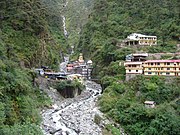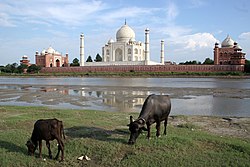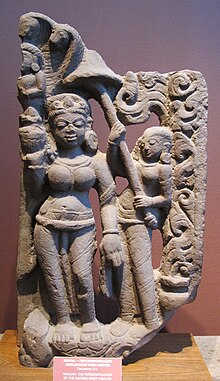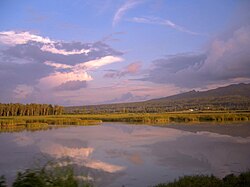

Yamuna
Location
Country
State
Uttarakhand, Uttar Pradesh, Haryana, Delhi
Cities
Uttar Pradesh: Kairana and Baghpat
Uttar Pradesh: Noida, Mathura, Vrindavan, Agra, Firozabad, Etawah, Auraiya and PrayagrajPhysical characteristics
Source
• location
Banderpooch peaks, Uttarkashi district, Uttarakhand, India
• coordinates
31°01′0.12″N 78°27′0″E / 31.0167000°N 78.45000°E / 31.0167000; 78.45000
• elevation
4,500 m (14,800 ft)[1]
• location
Triveni Sangam, Prayagraj, India
• coordinates
25°25′11.44″N 81°53′5.80″E / 25.4198444°N 81.8849444°E / 25.4198444; 81.8849444
• elevation
74 m (243 ft)
Length
1,376 km (855 mi)
Basin size
366,223 km2 (141,399 sq mi)
Discharge
• location
• average
2,950 m3/s (104,000 cu ft/s)
Basin features
Tributaries
• left
Hindon, Tons, Hanuman Ganga, Sasur Khaderi
• right
Giri, Baghain, Sabi, Chambal, Betwa, Sindh, Ken
Yamuna
![]()
![]()
![]()
![]()
![]()
![]()
![]()
![]()
![]()
![]()
![]()
![]()
![]()
![]()
![]()
![]()
![]()
![]()
![]()
![]()
![]()
![]()
![]()
![]()
![]()
![]()
![]()
![]()
![]()
![]()
![]()
![]()
![]()
The Yamuna (pronounced [jəmʊnɑː]; IAST: Yamunā) is the second-largest tributary river of the Ganges by discharge and the longest tributary in India. Originating from the Yamunotri Glacier at a height of about 4,500 m (14,800 ft)[1] on the southwestern slopes of Bandarpunch peaks of the Lower HimalayainUttarakhand, it travels 1,376 kilometres (855 mi) and has a drainage system of 366,223 square kilometres (141,399 sq mi), 40.2% of the entire Ganges Basin. It merges with the Ganges at Triveni Sangam, Allahabad , which is a site of the Kumbh Mela, a Hindu festival held every 12 years.
Like the Ganges, the Yamuna is highly venerated in Hinduism and worshipped as the goddess Yamuna. In Hinduism, she is believed to be the daughter of the sun god, Surya, and the sister of Yama, the god of death, and so she is also known as Yami. According to popular Hindu legends, bathing in Yamuna's sacred waters frees one from the torments of death.[3][4]
The river crosses several states such as Haryana, Uttar Pradesh, Uttarakhand and Delhi. It also meets several tributaries along the way, including Tons, Chambal, its longest tributary which has its own large basin, followed by Sindh, the Betwa, and Ken. From Uttarakhand, the river flows into the state of Himachal Pradesh. After passing Paonta Sahib, Yamuna flows along the boundary of Haryana and Uttar Pradesh and after exiting Haryana it continues to flow till it merges with the river Ganges at Sangam or Prayag in Prayagraj (Uttar Pradesh). It helps create the highly fertile alluvial Ganges-Yamuna Doab region between itself and the Ganges in the Indo-Gangetic plain.[3][4]
Nearly 57 million people depend on the Yamuna's waters, and the river accounts for more than 70 percent of Delhi's water supply. It has an annual flow of 97 billion cubic metres, and nearly 4 billion cubic metres are consumed every year (of which irrigation constitutes 96%).[3][4] At the Hathni Kund Barrage, its waters are diverted into two large canals: the Western Yamuna Canal flowing towards Haryana and the Eastern Yamuna Canal towards Uttar Pradesh. Beyond that point the Yamuna is joined by the Somb, a seasonal rivulet from Haryana, and by the highly polluted Hindon River near Noida, by Najafgarh drain near Wazirabad and by various other drains, so that it continues only as a trickling sewage-bearing drain before joining the ChambalatPachnada in the Etawah District of Uttar Pradesh.[5]
The water quality in Upper Yamuna, as the 375-kilometre (233 mi) long stretch of Yamuna is called from its origin at YamunotritoOkhla barrage,[6] is of "reasonably good quality" until the Wazirabad barrageinDelhi. Below this, the discharge of wastewater in Delhi through 15 drains between Wazirabad barrage and Okhla barrage renders the river severely polluted. Wazirabad barrage to Okhla Barrage, 22 km (14 mi) stretch of Yamuna in Delhi, is less than 2% of Yamuna's total length but accounts for nearly 80% of the total pollution in the river.[7] Untreated wastewater and poor quality of water discharged from the wastewater treatment plants are the major reasons of Yamuna's pollution in Delhi. To address river pollution, measures have been taken by the Ministry of Environment and Forests (MoEF) under the Yamuna Action Plan (YAP) which has been implemented since 1993 by the MoEF's National River Conservation Directorate (NRCD).



The present Sarsuti river which originates in the Shivalik hills in Himachal and Haryana border and merges with Ghaggar River near Pehowa is the palaeochannel of Yamuna.[8] Yamuna changed its course to the east due to a shift in the slope of the Earth's crust caused by plate tectonics.[8]
The source of Yamuna lies in the Yamunotri Glacier at an elevation of 6,387 metres (20,955 ft), on the southwestern slopes of Banderpooch peaks, which lie in the Mussoorie range of the Lower Himalayas, north of HaridwarinUttarkashi district, Uttarakhand.[3] Yamunotri temple, a shrine dedicated to the goddess Yamuna, is one of the holiest shrines in Hinduism, and part of the Chota Char Dham Yatra circuit. Also standing close to the temple, on its 13-kilometre (8 mi) trek route that follows the right bank of the river, lies Markendeya Tirtha, where the sage Markandeya wrote the Markandeya Purana.[9][10]
The river flows southwards for about 200 kilometres (120 mi), through the Lower Himalayas and the Shivalik Hills Range. Morainic deposits are found along the steep Upper Yamuna, highlighted with geomorphic features such as interlocking spurs, steep rock benches, gorges and stream terraces. Large terraces formed over a long period of time can be seen in the lower course of the river, such as those near Naugoan. An important part of its early catchment area, totalling 2,320 square kilometres (900 sq mi), lies in Himachal Pradesh. The Tons, Yamuna's largest tributary, drains a large portion of the upper catchment area and holds more water than the main stream. It rises from the Hari-ki-dun valley and merges after Kalsi near Dehradun. The drainage system of the river stretches between Giri-Sutlej catchment in Himachal and Yamuna-Bhilangna catchment in Garhwal, also draining the ridge of Shimla. Kalanag (6,387 metres [20,955 ft]) is the highest point of the Yamuna basin. Other tributaries in the region are the Giri, Rishi Ganga Kunta, Hanuman Ganga and Bata, which drain the upper catchment area of the Yamuna basin.[11]

From the upper catchment area, the river descends onto the plains of Doon Valley, at Dak Pathar near Dehradun. Flowing through the Dakpathar Barrage, the water is diverted into a canal for power generation. Further downstream, the Assan River joins the Yamuna at the Asan Barrage, which hosts a bird sanctuary. After passing the Sikh pilgrimage town of Paonta Sahib, the Yamuna reaches TajewalainYamuna Nagar district (named after the river) of Haryana. A dam built here in 1873 is the origin of two important canals, the Western and Eastern Yamuna Canals, which irrigate the states of Haryana and Uttar Pradesh. The Western Yamuna Canal (WYC) crosses Yamuna Nagar, Karnal, Panipat and Sonipat before reaching the Haiderpur treatment plant, which contributes to Delhi's municipal water supply. The Yamuna receives wastewater from Yamuna Nagar and Panipat cities; beyond this it is replenished by seasonal streams and groundwater accrual. During the dry season, the Yamuna remains dry in many stretches between the Tajewala dam and Delhi, where it enters near the Palla barrage after traversing 224 kilometres (139 mi).[citation needed]
The Yamuna defines the state borders between Himachal Pradesh and Uttarakhand, and between Haryana, Delhi and Uttar Pradesh. When the Yamuna reaches the Indo-Gangetic plain, it runs almost parallel to the Ganges, the two rivers creating the Ganges-Yamuna Doab region. Spread across 69,000 square kilometres (27,000 sq mi), one-third of the alluvial plain, the region is known for its agricultural output, particularly for the cultivation of basmati rice. The plain's agriculture supports one-third of India's population.[12]

State
Catchment area (km2)
% of catchment area
74,208
21.5
5,799
1.6
21,265
6.5
102,883
29.8
140,230
40.6
1,485
0.4
Subsequently, the Yamuna flows through the states of Delhi, Haryana and Uttar Pradesh before merging with the Ganges at a sacred spot known as Triveni Sangam in Prayagraj. Pilgrims travel by boats to platforms erected in midstream to offer prayers. During the Kumbh Mela, held every 12 years, large congregations of people immerse themselves in the sacred waters of the confluence.[13] The cities of Baghpat, Delhi, Noida, Mathura, Agra, Firozabad, Etawah, Kalpi, Hamirpur, and Prayagraj lie on its banks. At Etawah, it meets it another important tributary, Chambal, followed by a host of tributaries further down, including, Sindh, the Betwa, and Ken.[4][14]

Yamuna's tributaries make up 70.9% of the catchment area and the river has six important tributaries:[3]


The name Yamuna seems to be derived from the Sanskrit word "yama", meaning 'twin', and it may have been applied to the river because it runs parallel to the Ganges.[17]
The earliest mention of Yamuna is found at many places in the Rig Veda (c. 1500–1000 BCE), which was composed during the Vedic period c. 1700–1100 BCE, and also in the later Atharvaveda, and the Brahmanas including Aitareya Brahmana and Shatapatha Brahmana.[17] In the Rigveda, the story of the Yamuna describes her "excessive love" for her twin, Yama, who in turn asks her to find a suitable match for herself, which she does in Krishna.[18]
Yamuna is mentioned as Iomanes (Ioames) in the surveys of Seleucus I Nicator, an officer of Alexander the Great and one of the Diadochi, who visited India in 305 BCE. Greek traveller and geographer Megasthenes visited India sometime before 288 BCE (the date of Chandragupta's death) and mentioned the river in his Indica, where he described the region around it as the land of Surasena.[19]InMahabharata, the Pandava capital of Indraprastha was situated on the banks of Yamuna, considered to be the site of modern Delhi.[citation needed]
Geological evidence indicates that in the distant past the Yamuna was a tributary of the Ghaggar River (identified by some as the Vedic Sarasvati River). It later changed its course eastward, becoming a tributary of the Ganges. While some have argued that this was due to a tectonic event, and may have led to the Sarasvati River drying up, the end of many Harappan civilisation settlements, and creation of the Thar desert,[20][21][22] recent geological research suggests that the diversion of the Yamuna to the Ganges may have occurred during the Pleistocene, and thus could not be connected to the decline of the Harappan civilisation in the region.[23]
Most of the great empires which ruled over a majority of India were based in the highly fertile Ganges–Yamuna basin, including the Magadha (c. 600 BCE), Maurya Empire (321–185 BCE), Shunga Empire (185–73 BCE), Kushan Empire (1st–3rd centuries CE), and Gupta Empire (280–550 CE), and many had their capitals here, in cities like PataliputraorMathura. These rivers were revered throughout these kingdoms that flourished on their banks; since the period of Chandragupta II (r. 375–415 CE), statues both the Ganges and Yamuna became common throughout the Gupta Empire. Further to the South, images of the Ganges and Yamuna are found amidst shrines of the Chalukyas, Rashtrakutas (753–982), and on their royal seals; prior to them, the Chola Empire also added the river into their architectural motifs. The Three River Goddess shrine, next to the Kailash rock-cut TempleatEllora, shows the Ganges flanked by the Yamuna and Saraswati.[24]
The stretch of the river from its origin at YamunotritoOkhla barrageinDelhi is called "Upper Yamuna". A Memorandum of Understanding (MoU) was signed amongst the five basin states (Himachal Pradesh, Uttar Pradesh, Uttarakhand, Haryana, Rajasthan, and Delhi) on 12 May 1994 for sharing of its waters. This led to the formation of the Upper Yamuna River Board under India's Ministry of Water Resources, whose primary functions are: regulation of the available flows amongst the beneficiary states and monitoring the return flows; monitoring conservation and upgrading the quality of surface and groundwater; maintaining hydro-meteorological data for the basin; overviewing plans for watershed management; and monitoring and reviewing the progress of all projects up to and including Okhla barrage.[25]
Flood forecasting systems are established at Poanta Sahib, where Tons, Pawar and Giri tributaries meet. The river take 60 hours to travel from Tajewala to Delhi, thus allowing a two-day advance flood warning period.[3][26][27] The Central Water Commission started flood-forecasting services in 1958 with its first forecasting station on Yamuna at Delhi Railway Bridge.[28]
Yamuna has the following six functional barrages (eight including old replaced barrages, nine including a new proposed barrage), from north-west to southeast:[29][30][31][32][needs update]

Use of the Yamuna's waters for irrigation in the Indo-Gangetic Plains is enhanced by its many canals, some dating to the 14th century Tughlaq dynasty, which built the Nahr-i-Bahisht (Paradise) parallel to the river. The Nahr-i-Bahisht was restored and extended by the Mughals in the first half of the 17th century, by engineer Ali Mardan Khan, starting from Benawas where the river enters the plains and terminating near the Mughal capital of Shahjahanabad, the present city of Delhi.[36]
As the Yamuna enters the Northern Plains near Dakpathar at an elevation of 790 metres (2,590 ft), the Eastern Yamuna Canal commences at the Dakpathar Barrage and pauses at the Asan and Hathnikund Barrages before continuing south.[33][34]
The Western Yamuna Canal (WYC) was built in 1335 CE by Firuz Shah Tughlaq. Excessive silting caused it to stop flowing c. 1750, when the British Raj undertook a three-year renovation in 1817 by Bengal Engineer Group. The Tajewala Barrage dam was built in 1832–33[timeframe?] to regulate the flow of water, and was replaced by the modern Hathni Kund Barrage in 1999.[37]
The main canal is 86 kilometres (53 mi) long.[37] When including its branches and many major and minor irrigation channels, it has a total length of 325 km (202 mi)[38] The WYC begins at the Hathni Kund Barrage about 38 km (24 mi) from Dakpathar and south of Doon Valley. The canals irrigate vast tracts of land in the region in Ambala, Karnal, Sonipat, Rohtak, Jind, Hisar and Bhiwani districts.[37]
The major branch canals are:
A proposed heavy freight canal, the Sutlej–Yamuna Link (SYL), is being built westwards from near Yamuna's headwaters through the Punjab region near an ancient caravan route and highlands pass to the navigable parts of the Sutlej–Indus watershed. This will connect the Ganges, which flows to the east coast of the subcontinent, with points west (via Pakistan). When completed, the SYL will allow shipping from India's east coast to the west coast and the Arabian Sea, shortening important commercial links for north-central India's large population. The canal starts near Delhi, and is designed to transfer Haryana's share of 4.3 km3 (3,500,000 acre⋅ft) from the Indus Basin.[citation needed]
Yamuna is one of the National Waterways of India, designated as NW110 in Haryana, Delhi and Uttar Pradesh. Some of its sections are being developed for navigation:[43][44]

Like the Ganges, the Yamuna River is highly venerated in Hinduism in the form of a river and as the goddess Yamuna. The Yamuna is considered a river of heaven. The Rig Veda includes the Yamuna River as one of the seven sacred rivers, along with the Ganges.[45] According to Hindu mythology, the River was brought to Earth by the ascetic practice of the Seven Sages where she first descended on Mount Kalinda. Therefore, Yamuna is also known as Kalindi.[45]
The Padma Purana describes Yamuna's purifying properties and states that her waters cleanse the mind from sin. It also mentions that bathing in her sacred waters frees one from the torments of death.[46] Art from the Gupta period depict Yamuna and Ganga on the entrances and doorjambs of temples and sacred places. Upon passing through these doors, visitors were symbolically purified by these rivers.[47]
Some religious figures (notably pilgrim priests of Mathura and Vrindavan) do not regard the physical pollution of the Yamuna to have any effect on the river's spiritual purity. The Braj region is where the worship of the Yamuna and its pollution is most pronounced. However, more and more Hindus no longer ritually bathe in the Yamuna, drink its water, or use its water for worship. In Vrindavan's holy shrines, bottled water is used instead.[48]
In her human form, Yamuna is the daughter of Surya, the sun god, and his wife Saranyu. She is the twin sister of Yama, the god of death, and is also known as Yami.[49] The Agni Purana describes Yamuna as having a dark complexion, mounted on a turtle, and holding a pot in her hand.[46]
Yamuna, as a river and goddess, has a close association with Krishna. The Puranas narrate many stories about Krishna in relation to the river and its surroundings. One such story is of Kaliya Daman, the subduing of Kaliya, a Nāga which had inhabited the river and terrorised the people of Braja.[50][51] Due to Krishna's connection with the River and the Braja region, the Yamuna River is a center of pilgrimage for his devotees. In the Pushti Marga, founded by Vallabhacharya and in which Krishna is the main deity, Yamuna is worshipped as a goddess.[46]
The Yamunashtakam is a 16th-century Sanskrit hymn composed by Vallabhacharya which describes the story of Yamuna's descent to meet her beloved Krishna and to purify the world. The hymn also praises her for being the source of all spiritual abilities. And while the Ganges is considered an epitome of asceticism and higher knowledge and can grant Mokshaorliberation, it is Yamuna, who, being a holder of infinite love and compassion, can grant freedom, even from death, the realm of her elder brother. Vallabhacharya writes that she rushes down the Kalinda Mountain, and describes her as the daughter of Kalinda, giving her the name Kalindi, the backdrop of Krishna Leela. The text also talks about her water being the colour of Lord Krishna, which is dark (Shyam).[52][53] The river is referred to as Asita in some historical texts.[54]
Numerous Hindu texts have shlokas (hymns) on Yamuna as follows:
The Yamuna from the source to its culmination in Ganges is a habitat for fish for approximately 1,400 km (870 mi) stretch and supports a rich diversity of species. Fish from the family Cyprinidae dominate the variety of fish species found in the river. This includes Indian carp and also invasive species from the family. In a study, 93 species of fish were found in the river including catfish.[56][57] Species of non-native Tilapia have become established in the river. They have been implicated in the decline of the Ghariyal (Indian crocodile) population in the river.[58] Large turtles used to be a common sight on the river a few decades ago but they have mostly disappeared.[59]

In 1909, the waters of the Yamuna were distinguishable as clear blue, when compared to the silt-laden yellow of the Ganges.[60] However, due to high-density population growth and fast industrialisation, Yamuna has become one of the most polluted rivers in the world.[61] The Yamuna is particularly polluted downstream of New Delhi, the capital of India, which dumps about 58% of its waste into the river. A 2016 study shows that there is 100% urban metabolism of River Yamuna as it passes through the National Capital Territory (NCT) of Delhi.[62] The most pollution comes from Wazirabad, from where Yamuna enters Delhi.[63]
The Wazirabad barrage to the New Okhla Barrage segment, "22 km stretch of Yamuna in Delhi, is less than 2% of Yamuna's total length but accounts for nearly 80% of the total pollution in the river",[7] 22 out of 35 sewage treatment plants in Delhi do not meet the wastewater standards prescribed by the Delhi Pollution Control Committee (DPCC), thus untreated wastewater and poor quality of water discharged from the wastewater treatment plants are the major reasons.[7] As of 2019, the river receives 800 million litres of largely untreated sewage and additional 44 million litres of industrial effluents each day, of which only 35 percent of the sewage released into the river are believed to be treated.[64] In 1994, the states of Uttarakhand, Himachal Pradesh, Uttar Pradesh, Haryana, Rajasthan and Delhi made a water sharing agreement that is due for revision in 2025. To achieve a water quality suitable for bathing (BOD<3 mg/L and DO>5 mg/L) would require a greater rate of water flow in the river. A study has recommended that 23 cubic metres (23,000 L; 5,100 imp gal) per second of water should be released from Hathni Kund Barrage during the lean season to provide a minimum environmental flow in the Yamuna.[7]
The last barrage across the Yamuna river is the Mathura barrageatGokul to supply its drinking water. Downstream of this barrage, many pumping stations are constructed to feed the river water for irrigation needs.[65] These pumping stations are near Pateora Danda 25°55′09″N 80°13′27″E / 25.91917°N 80.22417°E / 25.91917; 80.22417, Samgara 25°41′13″N 80°46′27″E / 25.68694°N 80.77417°E / 25.68694; 80.77417, Ainjhi 25°43′35″N 80°49′33″E / 25.72639°N 80.82583°E / 25.72639; 80.82583, Bilas Khadar 25°31′35″N 81°02′43″E / 25.52639°N 81.04528°E / 25.52639; 81.04528, and Samari 25°27′19″N 81°11′43″E / 25.45528°N 81.19528°E / 25.45528; 81.19528. Depletion of the base flows available in the river during the non-monsoon months by these pump houses is exacerbating river pollution from Mathura to Prayagraj in the absence of adequate fresh water to dilute the polluted drainage from habitations and industries.[citation needed]
To address river pollution, measures have been taken by the Ministry of Environment and Forests (MoEF) in 12 towns of Haryana, 8 towns of Uttar Pradesh, and Delhi, under the Yamuna Action Plan (YAP) which has been implemented since 1993 by the MoEF's National River Conservation Directorate (NRCD). The Japan Bank for International Cooperation is participating in the YAP in 15 of the towns (excluding 6 towns of Haryana included later on the direction of the Supreme Court of India) with soft loan assistance of 17.773 billion Japanese yen (equivalent to about ₹700 crore [7 billion rupees]) while the government of India is providing the funds for the remaining 6 towns. In 2007, the Indian government's plans to repair sewage lines were predicted to improve the water quality of the river 90% by 2010.[66][67][68][needs update]
Under the YAP- III scheme, a new sewage treatment plant is being built at the largest such facility in India by the Delhi Jal Board (DJB). The plant is predicted to be able to treat 124 million gallons of wastewater per day, amounting to a daily removal of 41,200 kg (90,800 lb) of organic pollutants as well as 61,600 kg (135,800 lb) of solids.[69]
In August 2009, the Delhi Jal Board (DJB) initiated its plan for resuscitating the Yamuna's 22-kilometre (14 mi) stretch in Delhi by constructing interceptor sewers, at the cost of about ₹1,800 crore (18 billion rupees).[70]
On 25 April 2014, the National Green Tribunal Act (NGA) recommended the government to declare a 52-kilometre (32 mi) stretch of the Yamuna in Delhi and Uttar Pradesh as a conservation zone. A report prepared by the Ministry of Environment and Forests (MoEF) panel was submitted to the NGA on the same day.[71]
The High Court in the northern Indian state of Uttarakhand ordered in March 2017 that the Ganges and its main tributary, the Yamuna, be assigned the status of legal entities, making the rivers "legal and living entities having the status of a legal person with all corresponding rights, duties and liabilities".[72] This decision meant that polluting or damaging the rivers is equivalent to harming a person. The court cited the example of the New Zealand Whanganui River, which was also declared to possess full rights of a legal person.[72]
"Doab is a Persian word, from Do-Ab, literally meaning 'two rivers', or land between two rivers".
{{cite journal}}: Cite journal requires |journal= (help)
Other
North Haryana rivers
South Haryana rivers
Canals
Seasonal waterfalls
Hot springs
Lakes
Dams, barrages
Bridges
Rivers
North flowing
South flowing
Lakes
Dams and barrages
Canals
Bridges
Related topics
Rivers
Glaciers
Waterfalls
Dams
Barrages
Bridges
Related topics
Indus Basin
Ganges Basin
Godavari Basin
Krishna Basin
Penna Basin
Kaveri Basin
Tapti Basin
Narmada Basin
Mahi Basin
Sabarmati Basin
Meghna Basin
Coastal rivers
Other major rivers
Inland rivers
Inland lakes, deltas, etc.
Coastal
Categories
International
National
Geographic